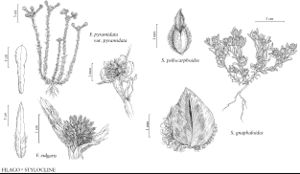Filago
Sp. Pl. 2: 927, 1199. 1753.
Gen. Pl. ed. 5, 397. 1754.
| Taxon | Illustrator ⠉ | |
|---|---|---|
 | Filago vulgaris Filago pyramidata var. pyramidata Stylocline gnaphaloides Stylocline psilocarphoides | Linny Heagy Linny Heagy Linny Heagy Linny Heagy |
Annuals, (1–) 5–40 cm. Stems [0] 1, ± erect, or 2–7 [–10+], ± ascending [prostrate]. Leaves cauline [basal]; alternate; blades lanceolate to oblanceolate [spatulate or ± round]. Heads in (dense, spheric [hemispheric]) glomerules of [2–] 8–35+ in ± dichasiiform arrays [borne singly]. Involucres 0 or inconspicuous. Phyllaries usually 0, rarely 1–4, unequal (similar to paleae). Receptacles cylindric to clavate (heights [2–] 5–15 times diams.), glabrous. Pistillate paleae (except usually innermost) ± persistent [falling], ± erect to ascending; bodies with 5+ nerves (nerves ± parallel, obscure), lanceolate to ovate, open to ± folded (each at most enfolding, not enclosing a floret); wings erect to recurved (apices acuminate to aristate). Innermost paleae usually all pistillate, in some species bisexual and pistillate, persistent or tardily falling, usually 5, erect to ascending [spreading] (scarcely enlarged) in fruit, shorter than other pistillate paleae; bodies lanceolate to ovate. Pistillate florets [12–] 27–40+. Functionally staminate florets 0. Bisexual florets (1–) 2–9 (–11); corolla lobes 4, ± equal. Cypselae brown, ± monomorphic: terete to ± compressed, cylindric to ± obovoid, usually straight, not gibbous, faces papillate to muricate [glabrous, smooth], dull; corolla scars apical [subapical]; pappi: outer pistillate 0, inner pistillate and bisexual of [3–] 13–21 bristles (visible in heads). x = 14.
Distribution
Introduced; Europe, w Asia, n Africa, Atlantic Islands, in North America, Australia
Discussion
Species 12(–23) (2 in the flora).
See discussion of Filagininae following the tribal description (p. 385).
The name Filago has been used also for the genus now usually recognized as Evax Gaertner. Here Filago, in the narrow sense, contains twelve Old World species. Six species long included in Filago in North America are here separated as Logfia.
Filago species grow in open, dry or somewhat moist habitats of arid, semiarid, Mediterranean, and humid-temperate to subtropical climates. The species in the flora grow in disturbed habitats; neither appears to be aggressively weedy.
Filago appears to be sister to or derived from Logfia and is probably ancestral to Evacopsis and Evax (J. D. Morefield 1992). Filago is most easily recognized by outer epappose florets subtended by open or ± folded, persistent, acuminate to aristate paleae, and prominent pappi on inner pistillate and bisexual florets.
Selected References
Lower Taxa
Key
| 1 | Largest leaves oblong to lanceolate, widest in proximal 2/3; heads in glomerules of (15–)20–35+, narrowly ± ampulliform, largest 1.5–2 mm diam.; pistillate paleae spirally ranked, longest 3.5–4.2 mm, innermost surrounding 14–25+ florets (10–20+ pistillate); longest dis- tal capitular leaves 0.8–1.1 times head heights, acute | Filago vulgaris |
| 1 | Largest leaves oblanceolate to narrowly spatulate, widest in distal 1/3; heads in glomerules of mostly (8–)12–16(–20), ± bipyramidal, largest 2.5–4 mm diam.; pistillate paleae vertically ranked, longest 4.5–6 mm, innermost surrounding 8–13 florets (2–7 pistillate); longest dis- tal capitular leaves 1.3–2 times head heights, obtuse | Filago pyramidata |